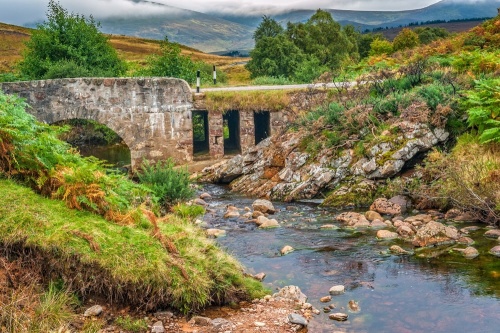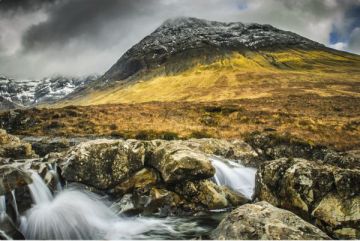
Late in the year 1868 Robert Nelson Gilchrist discovered gold in the rivers and small burns of Kildonan Strath, west of Helmsdale. When news of Gilchrist's discovery leaked out, it sparked an influx of over 600 prospectors who descended on the area in search of gold.
The frenetic and short-lived event has been dubbed, 'The Great Sutherland Gold Rush' and was centred on Baile an Or, on Kildonan Burn, where an interpretation panel gives details of the once-thriving shanty town that was the hub of prospecting activity.
Robert Gilchrist
Robert Gilchrist was a native of Gartymore, near Helmsdale, who had spent two decades prospecting in Australia. On his return to his native Sutherland, Gilchrist noticed the similarity of the small burns and creeks of the Strath to the gold-bearing geology of the sites he had prospected in Australia.
With the permission of the Duke of Sutherland, Gilchrist began to pan for gold. He found it.

His first discovery of gold came on his first day of panning in Torrish Burn. The best results, however, were in Kildonan Burn and Suisgill Burn.
Naturally enough, Gilchrist wanted to keep the news to himself, but an account of the discovery was published in the 28 January 1869 edition of the Inverness Courier. The announcement that gold had been founded prompted prospectors to descend on the Strath.
Baile an Or
Two temporary settlements sprang up; a shanty town of wooden huts on Kildonan Burn, and a tent village near Suisgill Burn, two miles further north. The settlement at Kildonan Burn was called Baile an Or (Gaelic for 'Town of Gold', and the settlement at Suisgill Burn was Carn na Buth (the 'Hill of Tents').
Realising that the influx of visitors was getting out of hand, the Duke of Sutherland decided that prospectors had to be licensed. Mining licenses cost £1 per month, and miners had to give a crown royalty (essentially a tax) on 10% of all gold found.

The Duke visited the encampment in person in April, and was so pleased with the reception given him by the miners that he promised to send them an ox and a cask of beer from his Dunrobin estate.
The licensing scheme caused a drop in the number of prospectors to something around 200 men. Numbers fell further when the herring season began and many men left for what amounted to more certain returns in the herring fishery. Also affecting the number of prospectors was the fact that that the amount of gold was dropping steadily.
The Duke soon realised that the prospecting caused disruption to fishing, stalking game, and raising sheep in the Strath, and in October he decreed that all mining activity must stop on 1 January 1870.
The Great Sutherland Gold Rush lasted just over a year.

What to See
No evidence of the once-bustling shanty town of Baile an Or now remains. Evidence of mining activity is gone, in part because the Duke required that all mine pits be 'levelled up', that is, filled in and made free of holes.
The site has been excavated by archaeologists, and they found remains of the village store, miner's huts, and a bunkhouse. Small items like the bowl of a clay pipe were unearthed, along with pieces of pottery, metal, and glass. These items are now on display at the Timespan Museum in Helmsdale, where you can learn more about the gold rush and read biographies of some of the miners.

Panning for Gold
The Baile an Or site is now part of the Suisgill state, and you can obtain a license to pan for gold in specified areas of Kildonan Burn for up to two weeks a year. Thee are details on the information panel at Baile an Or.
There is not much to see at Baile an Or, but it is well worth a stop to find out more about the gold rush, and to wonder what the landscape along Kildonan Burn would have looked like during those heady days of 1869 when the area was buzzing with activity.
Visiting
On the A897 just south of Kildonan Lodge, between Helmsdale and Kinbrace. There is a parking area on the north-east side of the road and an information panel beside the parking area.
About Baile an Or
Address: A897,
Kildonan,
Sutherland,
Scotland, KW8 6HY
Attraction Type: Countryside
Location: On the A897 just south of Kildonan Lodge. The nearest postcode is KW8 6HY, which centres on Duible, 2km to the south-east of Baile an Or.
Website: Baile an Or
Location
map
OS: NC911213
Photo Credit: David Ross and Britain Express
NEARBY HISTORIC ATTRACTIONS
Heritage Rated from 1- 5 (low to exceptional) on historic interest
Timespan - 8.2 miles (Museum) ![]()
Navidale Cemetery and St Ninian's Chapel - 8.7 miles (Historic Church) ![]()
Badbea Clearance Village - 11 miles (Museum) ![]()
Carn Liath Broch - 13.1 miles (Prehistoric Site) ![]()
Dunrobin Castle - 13.1 miles (Historic House) ![]()
Dunbeath Heritage Centre - 16.1 miles (Museum) ![]()
Laidhay Croft Museum - 17 miles (Museum) ![]()
Gloomy Memories Memorial - 19.1 miles (Historic Building) ![]()
Nearest Holiday Cottages to Baile an Or:
Nearby accommodation is calculated 'as the crow flies' from Baile an Or. 'Nearest' may involve a long drive up and down glens or, if you are near the coast, may include a ferry ride! Please check the property map to make sure the location is right for you.
Rogart, Highlands and Islands
Sleeps: 4
Stay from: £1215.00 - 4375.00
Dunbeath, Highlands and Islands
Sleeps: 4
Stay from: £487.00 - 1991.00
Rogart, Highlands and Islands
Sleeps: 4
Stay from: £1373.00 - 4369.00
More self catering near Baile an Or



